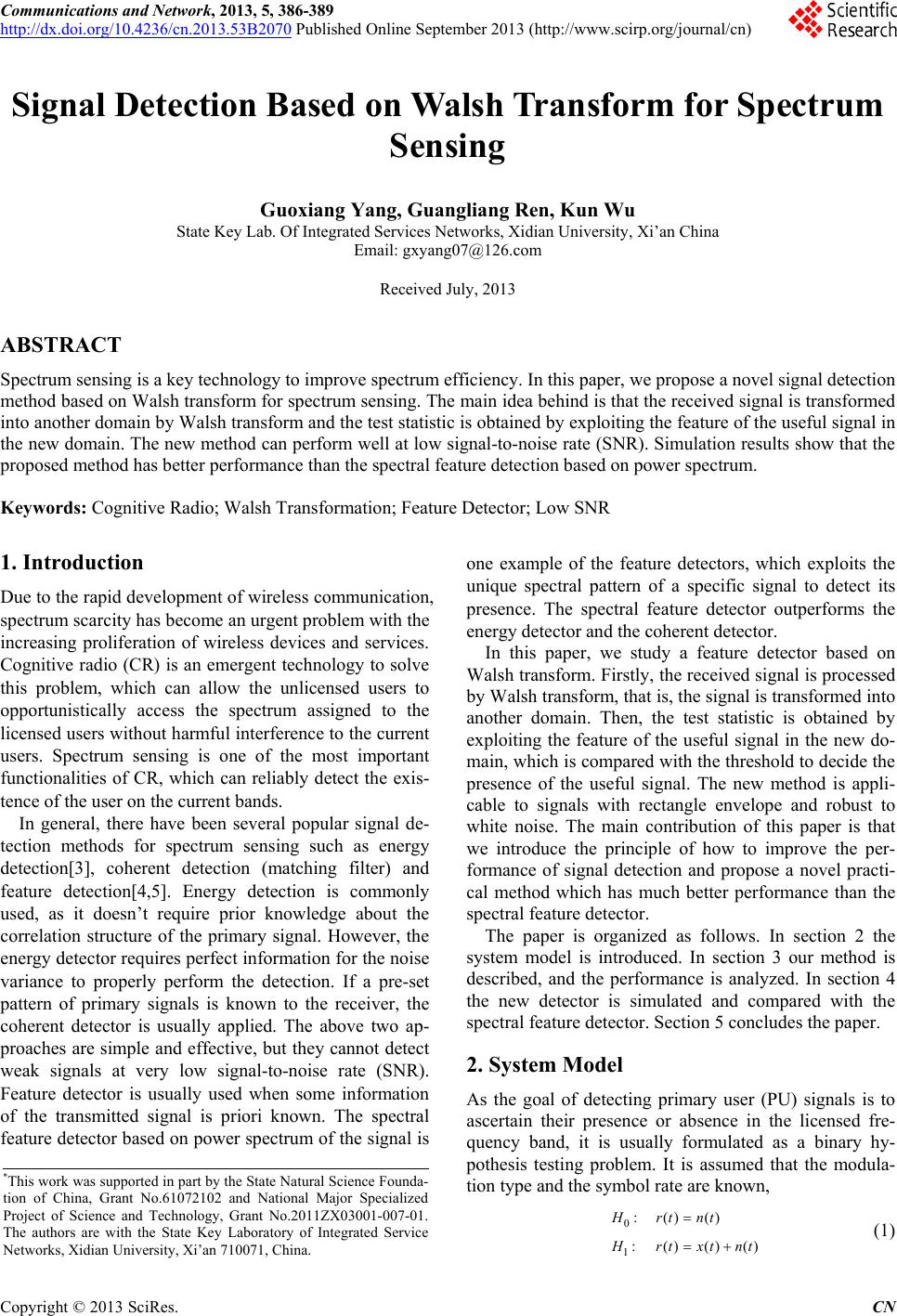
Communications and Network, 2013, 5, 386-389
http://dx.doi.org/10.4236/cn.2013.53B2070 Published Online September 2013 (http://www.scirp.org/journal/cn)
Signal Detection Based on Walsh Transform for Spectrum
Sensing
Guoxiang Yang, Guangliang Ren, Kun Wu
State Key Lab. Of Integrated Services Networks, Xidian University, Xi’an China
Email: gxyang07@126.com
Received July, 2013
ABSTRACT
Spectrum sensing is a key technology to improve spectrum efficiency. In this paper, we propose a novel signal detectio n
method based on Walsh transform for spectrum sensing. The main idea behind is that the received signal is transformed
into another domain by W alsh transform and the test statistic is obtained by exploiting the feature of the useful signal in
the new domain. The new method can perform well at low signal-to-noise rate (SNR). Simulation results show that the
proposed method has better performance than the spectral feature detection based on power spectrum.
Keywords: Cognitive Radio; Walsh Transformation; Feature Detector; Low SNR
1. Introduction
Due to the rapid development of wireless communication,
spectrum scarcity has become an urgent problem with the
increasing proliferation of wireless devices and services.
Cognitive radio (CR) is an emergent technology to solve
this problem, which can allow the unlicensed users to
opportunistically access the spectrum assigned to the
licensed users without harmful interference to the current
users. Spectrum sensing is one of the most important
functionalities of CR, which can reliably detect the exis-
tence of the user on the current bands.
In general, there have been several popular signal de-
tection methods for spectrum sensing such as energy
detection[3], coherent detection (matching filter) and
feature detection[4,5]. Energy detection is commonly
used, as it doesn’t require prior knowledge about the
correlation structure of the primary signal. However, the
energy detector requires perfect information for the noise
variance to properly perform the detection. If a pre-set
pattern of primary signals is known to the receiver, the
coherent detector is usually applied. The above two ap-
proaches are simple and effective, but they cannot detect
weak signals at very low signal-to-noise rate (SNR).
Feature detector is usually used when some information
of the transmitted signal is priori known. The spectral
feature detector based on power spectrum of the signal is
one example of the feature detectors, which exploits the
unique spectral pattern of a specific signal to detect its
presence. The spectral feature detector outperforms the
energy detector and the coherent detector.
In this paper, we study a feature detector based on
Walsh transform. Firstly, the received signal is processed
by Walsh transform, that is, the sign al is transfo r med into
another domain. Then, the test statistic is obtained by
exploiting the feature of the useful signal in the new do-
main, which is compared with the thresho ld to decide the
presence of the useful signal. The new method is appli-
cable to signals with rectangle envelope and robust to
white noise. The main contribution of this paper is that
we introduce the principle of how to improve the per-
formance of signal detection and propose a novel practi-
cal method which has much better performance than the
spectral feature detector.
The paper is organized as follows. In section 2 the
system model is introduced. In section 3 our method is
described, and the performance is analyzed. In section 4
the new detector is simulated and compared with the
spectral feature detector. Section 5 concludes the paper.
2. System Model
As the goal of detecting primary user (PU) signals is to
ascertain their presence or absence in the licensed fre-
quency band, it is usually formulated as a binary hy-
pothesis testing problem. It is assumed that the modula-
tion type and the symbol rate are known,
*This work was supported in part by the State Natural Science Founda-
tion of China, Grant No.61072102 and National Major Specialized
Project of Science and Technology, Grant No.2011ZX03001-007-01.
The authors are with the State Key Laboratory of Integrated Service
etworks, Xidian University, Xi’an 710071, China.
0
1
:()()
:()()(
Hrtnt
)
rtxt nt
(1)
C
opyright © 2013 SciRes. CN